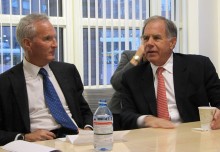
November 15, 2010 — The Shorenstein Center hosted an event for students to discuss the economy with Douglas W. Shorenstein, Deputy Chairman of the Federal Reserve Bank of San Francisco and Chairman and CEO of Shorenstein Properties LLC; and T. Gary Rogers, Chairman of the Board of the Federal Reserve Bank of San Francisco, former Chairman and CEO of Dreyer’s Grand Ice Cream, Inc., and former Chairman of the Board of Levi Strauss & Co. The event was co-sponsored by the Mossavar-Rahmani Center for Business and Government.
Shorenstein began the discussion by stating that “few people understand the Fed, even well-informed people.” Describing it as the “fourth branch of government,” Shorenstein enumerated the various tasks of the Federal Reserve Bank: circulating currency, lending to member banks, issuing banking regulations. According to Shorenstein, the “largest threat facing the Fed today is politics.” The Fed is an “independent entity, but it is controlled by Congress,” he said. Shorenstein warned that “making monetary policy by political means” can lead to serious problems.
Rogers said that although the recession is “fully behind us,” growth has been small at only two percent of the GDP. The “economy is fully stalled out,” he said, because “consumer spending is 70% of the economy, so when consumer confidence is down, the economy is not going to grow.” Surprisingly, businesses have become “more profitable,” Rogers said. “Productivity is up,” he explained, but this increase “hasn’t done much in driving revenue or creating jobs.” There is a “huge amount of uncertainty in business that is holding back normal economic growth,” he concluded.
This article was written by Janell Sims and photos taken by Heather McKinnon, both of the Shorenstein Center.

